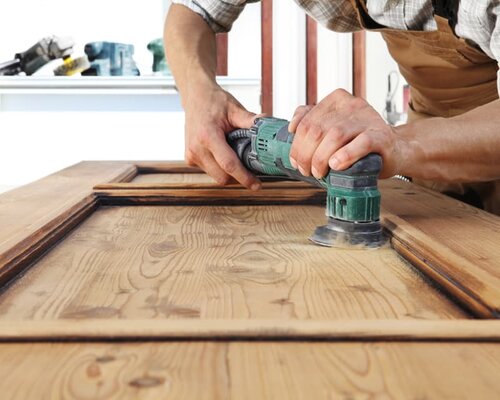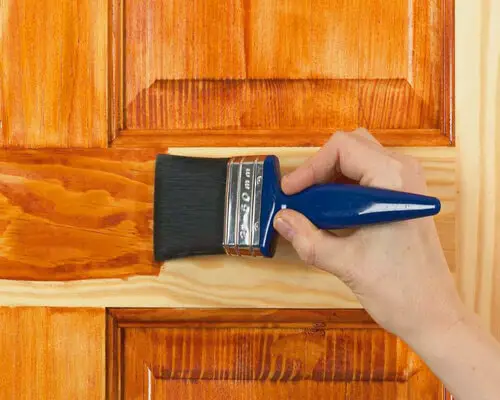How to Stain Pine Doors [Easy Guide]
A pine door stain adds a warm, natural feel to a room. The stain accentuates the natural beauty of the grain of the pine. Learning how to stain pine doors is a simple procedure that takes two to three hours to complete, not including drying time.
It is recommended to use a wood stain with integrated varnish. This will take a step out of the process, without sacrificing a quality result.
How to Stain Pine Doors
In this article, we are going to show you how to stain pine doors with a step-by-step tutorial that we hope will be of great help to you.
Here are the steps how to stain pine doors:
- Remove the pinewood door
- Prepare the pine door for stain
- Sand the pine door
- Repair holes or cracks in the pine doors
- Apply the pre-stain on the pine door
- Stain Pine Doors
- Apply the seal to the pine door
Required Tools and Materials
- Wood stain
- Gloves
- Paint brushes
- Paint roller
- Masking tape (painter’s tape)
- Screwdriver
- Two Sawhorses
- Plastic drop cloth / Newspapers / Cardboard
- Wood Putty (only if necessary)
- Sandpaper
- Vacuum cleaner
- Primer or sealer
Step 1: Remove the pinewood door
Remove the pine door from the frame using a hammer and a flathead screwdriver to remove the hinge pins.
Hinge pins connect the hinge part of the door to the part that sits on the door frame. Pry the hinge pins with the screwdriver at an angle and use the hammer to gently tap the bottom of the screwdriver.
This will drive the pins up so they can be removed by hand. When all pins are removed, the door can be removed and transported to a work area.
Set up two sawhorses in a well-ventilated room. Sawhorses should be parallel to each other and spaced about 1.5 to 2 meters (5 to 6 feet) apart. Place the pine door on the saw horses.
If you do not want to do this step or it is not possible for you, protect both the wall and the handles or locks . Tape with protective paper around the frame and masking tape on the door mechanisms.
Step 2: Prepare the pine door surface for stain
After removing the pine door, dismantle all fittings. Non-removable handles and hinges can be wrapped with paper, secured with tape or wrapped in foil. Fix the lock mechanism and seal with adhesive tape.
Secure the doorknob and other hardware to the door with tape to protect it from staining. Also lay out the area around the door frame with plastic drop cloth or cardboard so that you don’t drip wood stain onto the floor.
If you bought a new pine door, without various surface defects, you do not have to pre-treat it and you can skip this steps and go to step 5. If the pine door has various irregularities, chips, etc., it must be sanded before painting.
And the most convenient and fastest way to remove the old coating involves using a grinder or drill with a brush attachment. Sandpaper is used for the final removal of old stain and the elimination of the smallest irregularities.
Proceed to sand the pine wood door. Don’t forget to wear gloves on this step.
Step 3: Sand the pine door

Completely sand the pine door jamb and trim panels in the direction of the grain with 100-grit sandpaper. The door jamb is what you see attached to the left, right and top of the door frame when you open the inner door, and in which the strike plate is stuck on one side.
Start sanding down the so-called door leaf, i.e. the door itself.
Sand one side of the pine door completely with 100 grit sandpaper until all that is left is the smooth natural wood grain. Flip the pine door over and sand the other side. The purpose of sanding is to remove any paint that may be on the door and to smooth out any notch or gouges.
Step 4: Repair holes or cracks in the pine doors
Perform pre-sanding. This will help remove minor dents, scratches, and paint residue. Sanding can be made with a sander with medium-grained.
Check that your pine door has no scratches, holes or cracks. If you have any holes or cracks in the pine door, you can now fill them in with two-component putty or wood filler (you can get it at hardware stores) according to the package instructions.
After the putty has completely dried, sand the pine wood door again with sandpaper: first medium-grained, and then fine-grained. You can also seal cracks in the door frame with acrylic.
Carefully remove the sanding dust preferably with a vacuum cleaner.
Step 5: Apply the pre-stain on the pine door
If the pine door has glass elements carefully cover them with masking tape. Make sure you have tools and materials close at hand, because the next few steps should be uninterrupted.
Using a brush, first apply the primer along the pine door frame, then to the edges of the door leaf. In this way, you can avoid excess color drips that get on the frames when you treat the door leaf work into the paint layer while they are still wet. Once they have dried, unsightly drops appear in the paintwork.
Switch to the foam roller and quickly apply the undercoat to the larger parts of the pine door.
Let the pre-paint dry well overnight and then sand all the pre-painted parts again with 220 grit sandpaper.
Turn the pine door panel over and place the pre-painted and sanded side on the painter’s stands. Repeat the pre-staining and sanding process for the untreated part of the pine door.
Gluing glass to wood can be an easy job if you follow this simple step by step guides!
Step 6: Stain Pine Doors

If the pine door does not have panels and various irregularities, a small roller can be used to apply the wood stain. In the case of the presence of any decorative elements, you will have to use a brush.
First we need a brush which must be of excellent quality and with soft and compact bristles so that they never come off the brush during pine door staining procedure.
It is very important to thoroughly mix the stain with a spatula before starting work, shaking is not allowed, since air bubbles may form.
Dip a two-inch paintbrush into a stain and scrape the excess over the edge of the wood stain can. Start at the top corner of one side of the door and apply the stain in long, even strokes.
As with the undercoat, use a brush to apply the wood stain first to the pine door frame and then to the corners and edges of the door leaf.
Then stain the large door areas with the roller. When the first layer of stain has dried, stain the pine door a second time, should it be necessary and desired by you.
If the stain layer is thicker, you can wipe the brush with a clean cloth and disperse the excess wood stain with it. Drying of the first layer takes 2-4 hours depending on the temperature and humidity in the room.
Wait for the drying time as indicated by the manufacturer, in general it is highly recommended to wait from one day to the next. Once the first coat of stain dries, sand lightly once more, and proceed to apply another coat of stain, until the color of the pinewood door stain is even and uniform.
Apply the second layer of stain to the pine door. The material is also applied strictly along the grain of the wood. Since the second layer is no longer so deeply absorbed, the drying time will take a little longer than 3-5 hours.
When the stain has dried well, turn the pine door panel over and place the stain side on the painter’s stands. Now start to stain the second side of the pine door and also let it dry very well. If necessary, repeat steps two and three again.
When the first side of the door is done, let it dry according to the instructions on the box. Stain the other side of the door. Let the second side dry completely.
Step 7: Apply the seal to the pine door
Pine is a porous wood, with a great absorption of stain. Keep in mind that the higher the porosity, the more amount of seal you will need to apply.
The pine door is sealed with another chemical called sealer, this is applied after the wood stain has dried and once again, we hope that it dries very well, to sand again which will allow the pores of wood are perfectly covered or sealed.
Wood sealers or wood primers are suitable depending on the type of subsequent varnish, and are often used in the varnishing of some floors and special furniture. It is not always necessary, and should never be used before the application of protective seal.
Screw the rosette and the door handle back on, reinstall the door by reversing the process you used to remove it.
Tips How to Stain Pine Doors
- To achieve the desired shade, more than one layer of stain can be used, as long as it is absorbed by the pine door. In all cases, one coat should be allowed to dry completely before laying the next.
- Not all parts of the same pine door are stained to the same intensity. When the wood fibers are parallel to the surface as on the faces and edges of a board, the color of the tint is acquired in some cases more, and in others less, than at cross-sectional edges where the fibers are perpendicular to the surface of the board. job. This means that some pine door parts should receive more layers of stain than others.
- Pine wood absorbs stain very quickly, so if you’ve already started staining the wood you should continue to the end. If work is interrupted even for a few minutes, the joining edge of both staining processes will be marked on the pine door surface.
- Be careful, a very “strong” stain can make the grain of the pine wood disappear, which in many cases is sought to be preserved.
- Lacquers and varnishes are not perfectly transparent and generally darken the finished wood somewhat (usually amber), so pre-staining should leave a “reservoir” of color in the final finish.
- If you’re using a water-based stain, allow it to dry completely before varnishing or lacquering.
Frequently Asked Questions
White-based Stains tints pine doors white while letting the stain show through the natural grain . Ideal for pine wood, whitewash stain tones down the yellow associated with pine furniture with a lighter, brighter hue.
A treated door pine retaining wall can be upgraded to look like hardwood simply by applying a good quality wood stain such as premium wood stains . Then the door frame was left to dry completely for 24 hours.
Pine is difficult to stain for a few reasons. First, its grain is unevenly dense. Typical wood stains cause grain reversal because they only color the porous primeval wood; they cannot penetrate dense late wood. In short, the conditioner partially seals the surface of the wood to control the stain.
Conclusion
It is not very difficult to stain pine doors. You just need to know about some of the steps required for such work and do everything in accordance with the instructions.
Knowing how to stain pine doors is the easiest and most affordable way to give your doors a refresh look and give them a neater and more harmonious look.



